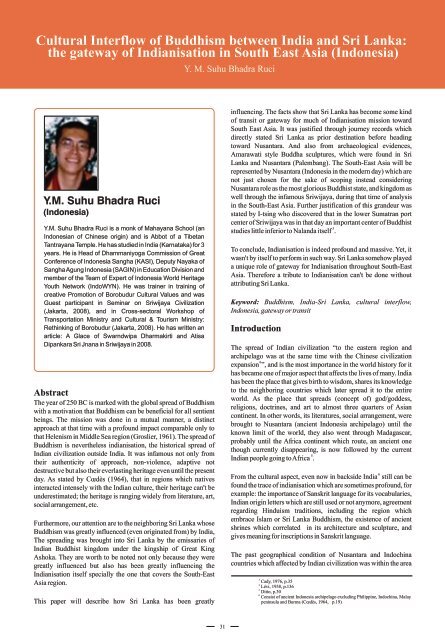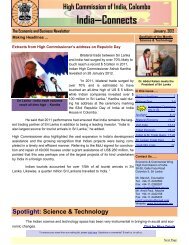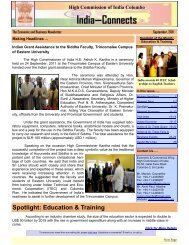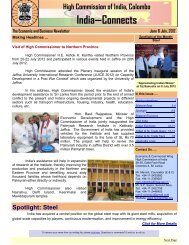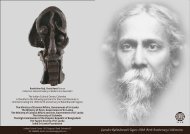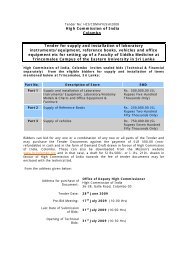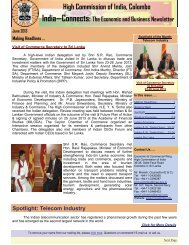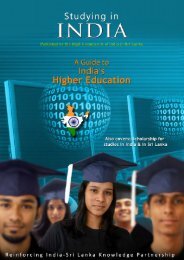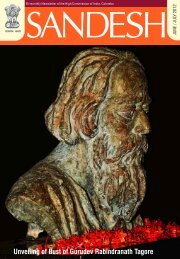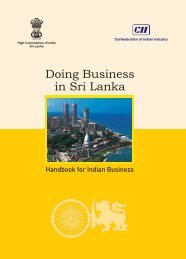Papers presented at the International Buddhist Conference, March ...
Papers presented at the International Buddhist Conference, March ...
Papers presented at the International Buddhist Conference, March ...
Create successful ePaper yourself
Turn your PDF publications into a flip-book with our unique Google optimized e-Paper software.
Cultural Interflow of Buddhism between India and Sri Lanka:<br />
<strong>the</strong> g<strong>at</strong>eway of Indianis<strong>at</strong>ion in South East Asia (Indonesia)<br />
Y. M. Suhu Bhadra Ruci<br />
Y.M. Suhu Bhadra Ruci<br />
(Indonesia)<br />
Y.M. Suhu Bhadra Ruci is a monk of Mahayana School (an<br />
Indonesian of Chinese origin) and is Abbot of a Tibetan<br />
Tantrayana Temple. He has studied in India (Karn<strong>at</strong>aka) for 3<br />
years. He is Head of Dhammaniyoga Commission of Gre<strong>at</strong><br />
<strong>Conference</strong> of Indonesia Sangha (KASI), Deputy Nayaka of<br />
Sangha Agung Indonesia (SAGIN) in Educ<strong>at</strong>ion Division and<br />
member of <strong>the</strong> Team of Expert of Indonesia World Heritage<br />
Youth Network (IndoWYN). He was trainer in training of<br />
cre<strong>at</strong>ive Promotion of Borobudur Cultural Values and was<br />
Guest participant in Seminar on Sriwijaya Civiliz<strong>at</strong>ion<br />
(Jakarta, 2008), and in Cross-sectoral Workshop of<br />
Transport<strong>at</strong>ion Ministry and Cultural & Tourism Ministry:<br />
Rethinking of Borobudur (Jakarta, 2008). He has written an<br />
article: A Glace of Swarndwipa Dharmakirti and Atisa<br />
Dipankara Sri Jnana in Sriwijaya in 2008.<br />
Abstract<br />
The year of 250 BC is marked with <strong>the</strong> global spread of Buddhism<br />
with a motiv<strong>at</strong>ion th<strong>at</strong> Buddhism can be beneficial for all sentient<br />
beings. The mission was done in a mutual manner, a distinct<br />
approach <strong>at</strong> th<strong>at</strong> time with a profound impact comparable only to<br />
th<strong>at</strong> Helenism in Middle Sea region (Groslier, 1961). The spread of<br />
Buddhism is never<strong>the</strong>less indianis<strong>at</strong>ion, <strong>the</strong> historical spread of<br />
Indian civiliz<strong>at</strong>ion outside India. It was infamous not only from<br />
<strong>the</strong>ir au<strong>the</strong>nticity of approach, non-violence, adaptive not<br />
destructive but also <strong>the</strong>ir everlasting heritage even until <strong>the</strong> present<br />
day. As st<strong>at</strong>ed by Cœdès (1964), th<strong>at</strong> in regions which n<strong>at</strong>ives<br />
interacted intensely with <strong>the</strong> Indian culture, <strong>the</strong>ir heritage can't be<br />
underestim<strong>at</strong>ed; <strong>the</strong> heritage is ranging widely from liter<strong>at</strong>ure, art,<br />
social arrangement, etc.<br />
Fur<strong>the</strong>rmore, our <strong>at</strong>tention are to <strong>the</strong> neighboring Sri Lanka whose<br />
Buddhism was gre<strong>at</strong>ly influenced (even origin<strong>at</strong>ed from) by India,<br />
The spreading was brought into Sri Lanka by <strong>the</strong> emissaries of<br />
Indian <strong>Buddhist</strong> kingdom under <strong>the</strong> kingship of Gre<strong>at</strong> King<br />
Ashoka. They are worth to be noted not only because <strong>the</strong>y were<br />
gre<strong>at</strong>ly influenced but also has been gre<strong>at</strong>ly influencing <strong>the</strong><br />
Indianis<strong>at</strong>ion itself specially <strong>the</strong> one th<strong>at</strong> covers <strong>the</strong> South-East<br />
Asia region.<br />
This paper will describe how Sri Lanka has been gre<strong>at</strong>ly<br />
influencing. The facts show th<strong>at</strong> Sri Lanka has become some kind<br />
of transit or g<strong>at</strong>eway for much of Indianis<strong>at</strong>ion mission toward<br />
South East Asia. It was justified through journey records which<br />
directly st<strong>at</strong>ed Sri Lanka as prior destin<strong>at</strong>ion before heading<br />
toward Nusantara. And also from archaeological evidences,<br />
Amaraw<strong>at</strong>i style Buddha sculptures, which were found in Sri<br />
Lanka and Nusantara (Palembang). The South-East Asia will be<br />
re<strong>presented</strong> by Nusantara (Indonesia in <strong>the</strong> modern day) which are<br />
not just chosen for <strong>the</strong> sake of scoping instead considering<br />
Nusantara role as <strong>the</strong> most glorious <strong>Buddhist</strong> st<strong>at</strong>e, and kingdom as<br />
well through <strong>the</strong> infamous Sriwijaya, during th<strong>at</strong> time of analysis<br />
in <strong>the</strong> South-East Asia. Fur<strong>the</strong>r justific<strong>at</strong>ion of this grandeur was<br />
st<strong>at</strong>ed by I-tsing who discovered th<strong>at</strong> in <strong>the</strong> lower Sum<strong>at</strong>ran port<br />
center of Sriwijaya was in th<strong>at</strong> day an important center of <strong>Buddhist</strong><br />
3<br />
studies little inferior to Nalanda itself .<br />
To conclude, Indianis<strong>at</strong>ion is indeed profound and massive. Yet, it<br />
wasn't by itself to perform in such way. Sri Lanka somehow played<br />
a unique role of g<strong>at</strong>eway for Indianis<strong>at</strong>ion throughout South-East<br />
Asia. Therefore a tribute to Indianis<strong>at</strong>ion can't be done without<br />
<strong>at</strong>tributing Sri Lanka.<br />
Keyword: Buddhism, India-Sri Lanka, cultural interflow,<br />
Indonesia, g<strong>at</strong>eway or transit<br />
Introduction<br />
The spread of Indian civiliz<strong>at</strong>ion “to <strong>the</strong> eastern region and<br />
archipelago was <strong>at</strong> <strong>the</strong> same time with <strong>the</strong> Chinese civiliz<strong>at</strong>ion<br />
4<br />
expansion ”, and is <strong>the</strong> most importance in <strong>the</strong> world history for it<br />
has became one of major aspect th<strong>at</strong> affects <strong>the</strong> lives of many. India<br />
has been <strong>the</strong> place th<strong>at</strong> gives birth to wisdom, shares its knowledge<br />
to <strong>the</strong> neighboring countries which l<strong>at</strong>er spread it to <strong>the</strong> entire<br />
world. As <strong>the</strong> place th<strong>at</strong> spreads (concept of) god/goddess,<br />
religions, doctrines, and art to almost three quarters of Asian<br />
continent. In o<strong>the</strong>r words, its liter<strong>at</strong>ures, social arrangement, were<br />
brought to Nusantara (ancient Indonesia archipelago) until <strong>the</strong><br />
known limit of <strong>the</strong> world, <strong>the</strong>y also went through Madagascar,<br />
probably until <strong>the</strong> Africa continent which route, an ancient one<br />
though currently disappearing, is now followed by <strong>the</strong> current<br />
5<br />
Indian people going to Africa .<br />
6<br />
From <strong>the</strong> cultural aspect, even now in backside India still can be<br />
found <strong>the</strong> trace of indianis<strong>at</strong>ion which are sometimes profound, for<br />
example: <strong>the</strong> importance of Sanskrit language for its vocabularies,<br />
Indian origin letters which are still used or not anymore, agreement<br />
regarding Hinduism traditions, including <strong>the</strong> region which<br />
embrace Islam or Sri Lanka Buddhism, <strong>the</strong> existence of ancient<br />
shrines which correl<strong>at</strong>ed in its architecture and sculpture, and<br />
gives meaning for inscriptions in Sanskrit language.<br />
The past geographical condition of Nusantara and Indochina<br />
countries which affected by Indian civiliz<strong>at</strong>ion was within <strong>the</strong> area<br />
3<br />
Cady, 1976, p.35<br />
4<br />
Lévi, 1938, p.136<br />
5<br />
Ditto, p.30<br />
6<br />
Consist of ancient Indonesia archipelago excluding Philippine, Indochina, Malay<br />
peninsula and Burma (Cœdès, 1964, p.19)<br />
31


